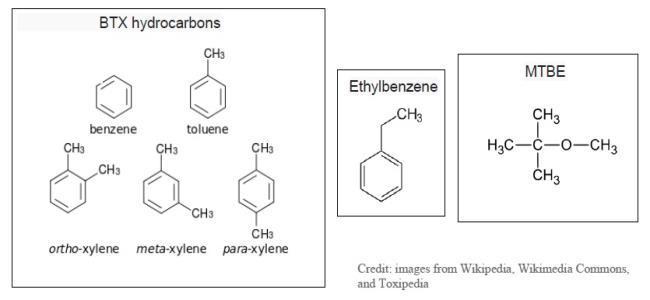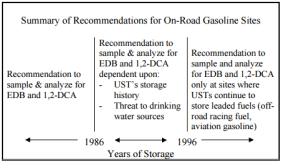Chemicals of Concern
Regulated substances may contain COCs (chemicals of concern) that can be harmful to human health or the environment. These COCs, if released from a regulated tank system, may pose an unacceptable risk. This guidance is intended to identify chemicals of concern and their associated analytical methods.
Primary COCs
Primary COCs include benzene, toluene, ethylbenzene, xylenes (BTEX) and methyl tert-butyl ether (MTBE) based on their prevalence in regulated petroleum products and their mobility in the subsurface. Primary COCs must be characterized after a release has been confirmed. Benzene is a COC based on its carcinogenic and toxicological properties, while toluene, ethylbenzene, and total xylenes are COCs based on their toxicological properties. Acute or chronic exposure to BTEX via inhalation, ingestion or direct contact pathways may cause increased carcinogenic or toxicological risk.
MTBE is an oxygenate that was used in Colorado from the late 1970s through 2002. Although EPA has not set a national standard for MTBE in drinking water, a Drinking Water Advisory was issued in 1997 that established a taste threshold of 0.04 mg/L and an odor threshold of 0.02 mg/L. EPA has developed Regional Screening Levels for MTBE. Groundwater ingestion is the only exposure pathway for MTBE.
BTEX and MTBE are required to be characterized in groundwater. BTEX must also be characterized in soil and potentially in soil vapor, depending on evaluation of the air exposure pathway
Additional information about primary COCs is available via the CDC and EPA's Water Resources and Risk-Based Screening Table.
Secondary COCs
Secondary COCs include TPHs (total petroleum hydrocarbons) and PAHs (polynuclear aromatic hydrocarbons). TPH is divided into the following three groups based on their range of carbon chains:
- Total volatile petroleum hydrocarbons (TVPH; gasoline range organics; C6-C10)
- Total extractable petroleum hydrocarbons (TEPH; diesel range organics; C11-C28)
- Total recoverable petroleum hydrocarbons (TRPH; oil range organics; C29-C35)
TPH must be fully defined to the threshold limit of 500 mg/kg in soil during the characterization phase. If a soil sample is collected at the soil-groundwater interface and is above the 500 mg/kg threshold limit, submerged soils should be collected until the soil is fully defined to 500 mg/kg. During the remediation phase, the continued analysis of TPH in groundwater should be evaluated on a site-specific basis.
PAHs must be characterized if the 500 mg/kg threshold limit for a TEPH or TRPH range in soil is exceeded. Some PAHs are considered secondary COCs based on their carcinogenic and toxicological properties. PAHs should be analyzed from the unsaturated soil sample with the highest TEPH or TRPH concentration that exceeds the threshold limit, regardless of the presence of BTEX. The priority PAHs are listed in the Tier I RBSLs table.
If PAH concentrations are below Tier I RBSLs in the unsaturated soil sample with the highest TEPH or TRPH concentration, no further PAH characterization is necessary. However, if PAH concentrations exceed Tier I RBSLs in the unsaturated soil sample, the vertical and horizontal extent should be defined to below Tier I RBSLs. If PAHs exceed Tier I RBSLs in the capillary fringe or smear zone, groundwater samples should be collected for PAH analysis. However, based on the ubiquitous presence of PAHs in urban areas from other sources (e.g., airborne deposition from automobile combustion; coal-tar based pavement sealers), a background groundwater sample must also be collected for PAH analysis at a location upgradient from and completely removed from the release source area.
Petroleum Fuel Additives
A variety of compounds have been added to petroleum fuels over the years to enhance certain performance properties of the fuel. The following COCs should be analyzed to determine if there is reason to suspect that the additives were used at the site. If these COCs are identified during characterization, additional monitoring and remediation will be handled on a site-specific basis.
1,2-DCA (1,2-Dichloroethane)
Between 1949 and 1989, 1,2-DCA was an anti-knock additive for leaded gasoline and was selected as a COC based on its toxicological properties. It is a potential carcinogen via the inhalation, absorption, ingestion and direct exposure pathways. A release site should be analyzed for 1,2-DCA if the site is suspected to have dispensed leaded gasoline and/or operated prior to 1996. Figure courtesy of EPA
Leaded gasoline was banned in 1989, but it can still show up in a release investigation.
EDB (Ethylene Dibromide)
EDB was mainly used as a lead scavenger in anti-knock gasoline mixtures (particularly in aviation fuel) and is a COC based on its carcinogenic and toxicological properties. It is a potential carcinogen via the inhalation, absorption, ingestion and direct contact exposure pathways. A release site should be analyzed for EDB if the site is suspected to have dispensed leaded gasoline.
Ethanol and Methane
Ethanol is a current oxygenate additive for gasoline and comprises 6-83% of the total fuel volume. Methane is a daughter product of ethanol and would most likely be found in soil vapor within the unsaturated zone. Methane is non-poisonous but can be an asphyxiant and an explosive hazard when mixed with air. A release site should be analyzed for ethanol and methane if the release is from an ethanol-blended fuel. Only methane gas should be analyzed to assess health or explosive risks where ethanol-rich fuels are stored. Methane in groundwater is minimal under natural conditions.
Other Regulated Compounds
There are several types of regulated products commonly used for commercial purposes. These include new lubricating oil, used waste oil, petroleum solvents and glycols. These other regulated compounds should be analyzed for if a release is confirmed from a regulated tank that contains these products. If these COCs are identified during characterization, additional monitoring and remediation will be handled on a site-specific basis.
New Lubricating Oil and Waste Oil
BTEX, TRPH and PAHs are required analytes for assessing releases from new lubricating oil or used waste oil tanks. Other parameters can and should be added consistent with information about the source of the waste. For example, if historical information or facility operational knowledge indicates non-petroleum or chlorinated solvents were disposed of in a waste oil tank, a full suite volatile organic compounds analysis is required to determine if there are any non-petroleum hazardous contaminants present that could adversely affect the environment. Contact the Colorado Department of Public Health and Environment at (303) 692-3300 if non-petroleum hazardous contaminants, such as chlorinated solvents, are present.
Petroleum Solvents
Petroleum solvents include rubber solvent, mineral spirits and naphtha. The analytical parameters for characterization and remediation efforts from tanks known to contain petroleum solvents include TVPH, volatile organic compounds, and PAHs. Petroleum solvents do not usually contain sufficient quantities of BTEX to allow their measurements in soil and water samples.
Glycols
Glycols are organic compounds that contain alcohol. The most common glycols are ethylene glycol and propylene glycol, which are used as antifreeze applications in automotive cooling systems and deicing operations at airports.
Laboratory Analytical Methods
Appropriate laboratory analytical methods must be used to detect and quantify substances present or suspected to be present at the site. The Regulated Substances table provides guidance on accepted analytical methods to use and is based on EPA publication SW-846. Methods for evaluating solid waste must be selected based on the need to measure contaminants at or below the lowest of the applicable cleanup levels.

